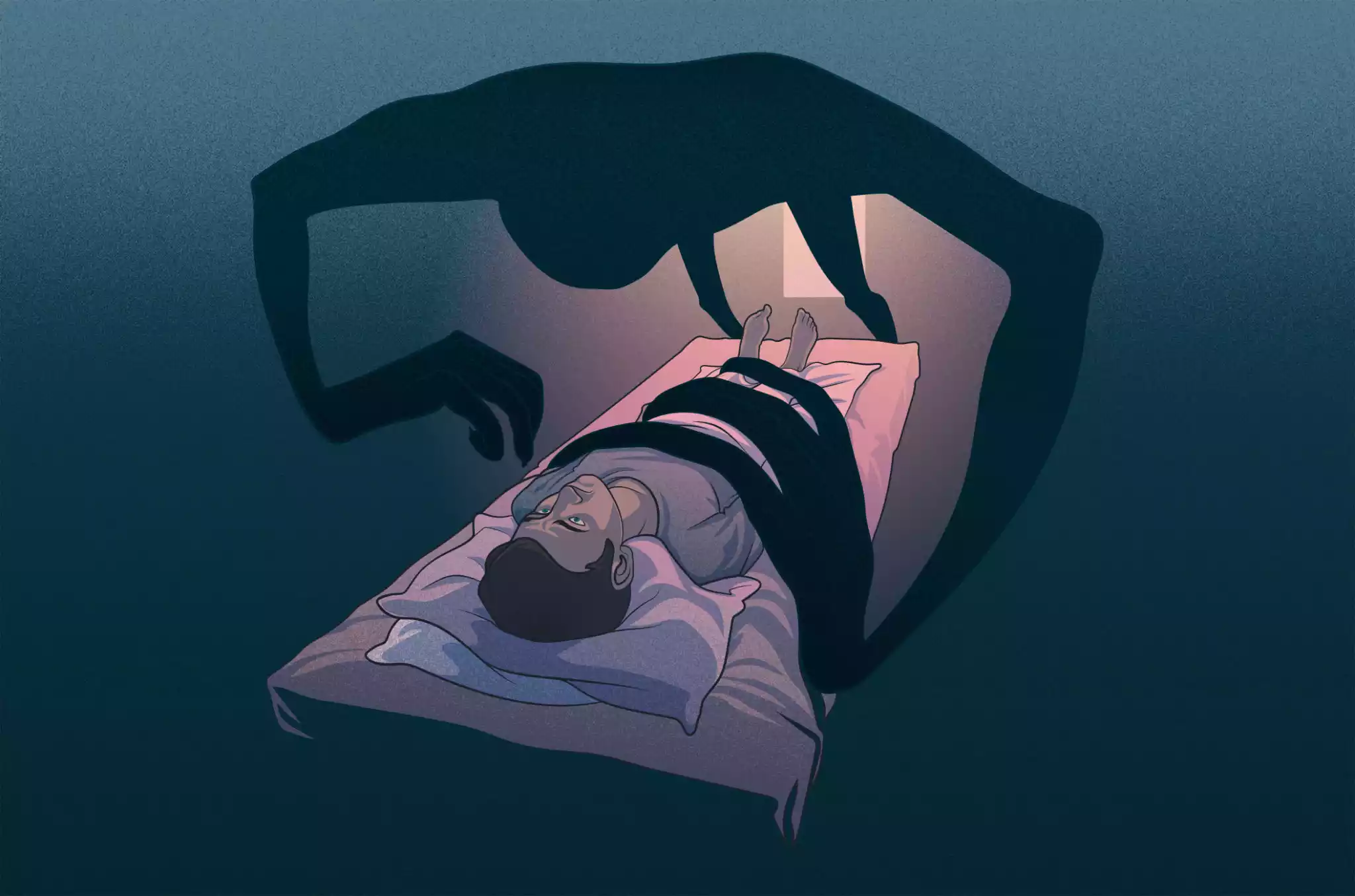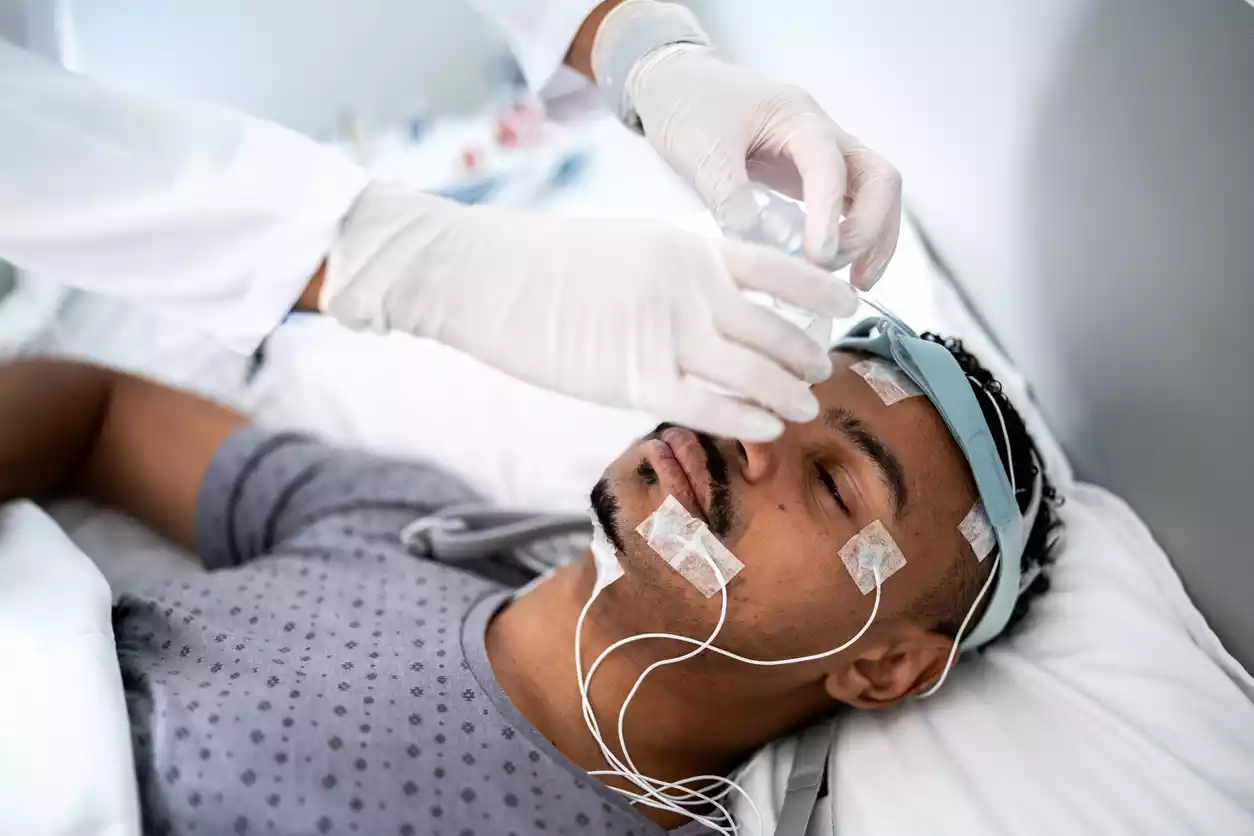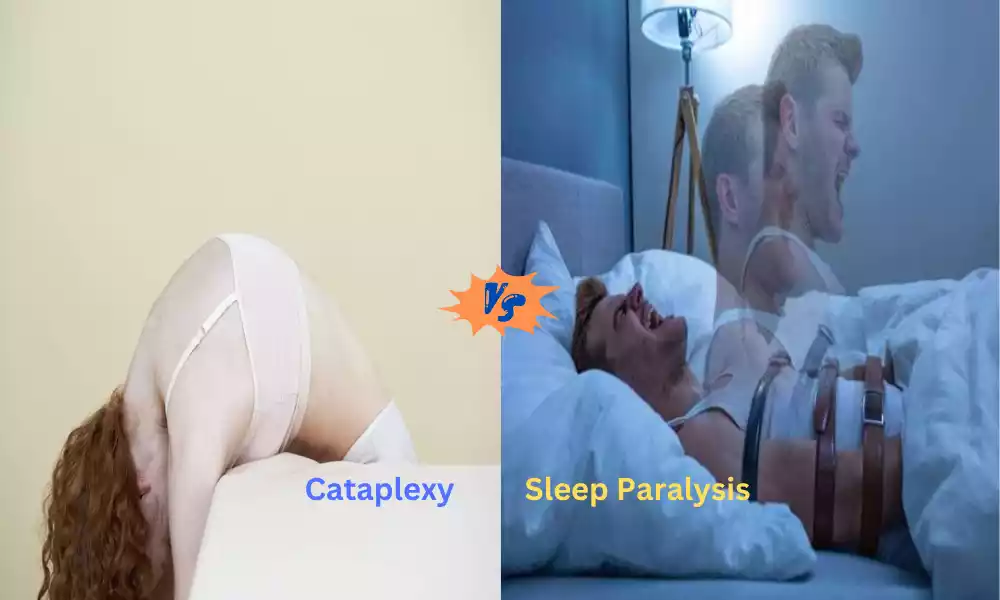Cataplexy and Sleep Paralysis are intriguing phenomena within the realm of sleep disorders. Cataplexy involves sudden muscle weakness triggered by strong emotions, often linked to narcolepsy. On the other hand, sleep paralysis is the temporary inability to move or speak upon waking or falling asleep, accompanied by vivid hallucinations. Both conditions disrupt the delicate balance of wakefulness and slumber, posing unique challenges for those who experience them.
What is Cataplexy?

Cataplexy is a unique and intriguing neurological phenomenon closely associated with narcolepsy, a sleep disorder characterized by excessive daytime sleepiness and sudden, uncontrollable bouts of sleep. What sets cataplexy apart is its link to emotions.
During cataplexy episodes, individuals experience a sudden and temporary loss of muscle tone, often triggered by heightened emotions such as laughter, surprise, or excitement. This can lead to a range of symptoms, from mild muscle weakness to complete paralysis, causing affected individuals to collapse or lose control over their movements for a brief period.
The underlying cause of cataplexy is the malfunction of the brain’s regulation of muscle activity during wakefulness. In individuals with narcolepsy, certain neurotransmitters that regulate sleep-wake cycles, such as hypocretin/orexin, are often deficient. These neurotransmitters play a crucial role in maintaining muscle tone and preventing sudden loss of control.
When emotions trigger cataplexy, there is a temporary disruption in these regulatory mechanisms, resulting in the characteristic muscle weakness or paralysis. Despite its seemingly sudden onset, cataplexy is a complex condition that can significantly impact an individual’s daily life and emotional well-being.
Diagnosing cataplexy involves a thorough medical evaluation, including clinical assessments and sleep studies. While there is no cure for cataplexy, treatment approaches aim to manage its impact on daily life. Lifestyle adjustments, stress management techniques, and proper sleep hygiene can be beneficial.
Medications such as selective serotonin and norepinephrine reuptake inhibitors (SNRIs) may be prescribed to mitigate the frequency and severity of cataplexy episodes. Understanding the unique nature of cataplexy is essential for both affected individuals and healthcare professionals, as it aids in developing effective strategies to cope with this distinctive facet of narcolepsy.
Causes of Cataplexy
- Hypocretin Deficiency: The primary cause of cataplexy is a deficiency of the neurotransmitter hypocretin, also known as orexin. Hypocretin plays a crucial role in regulating wakefulness and maintaining muscle tone during wakeful periods.
- Genetic Factors: Genetic predisposition can contribute to the development of cataplexy. Certain genetic markers are associated with narcolepsy and an increased susceptibility to experiencing cataplexy.
- Emotional Triggers: Strong emotions, particularly positive ones such as laughter, joy, or excitement, can trigger cataplexy episodes. These emotions disrupt the brain’s ability to control muscle tone.
- Autoimmune Reactions: Some evidence suggests that an autoimmune reaction might be involved in the destruction of the neurons responsible for producing hypocretin. This immune response can lead to a deficiency of hypocretin in the brain.
The interaction of these factors can result in the sudden loss of muscle control characteristic of cataplexy. It’s worth noting that cataplexy is often associated with narcolepsy, a condition that affects the sleep-wake cycle and can lead to excessive daytime sleepiness and other sleep-related disturbances. While there is no cure for cataplexy, various treatment approaches, including medications and lifestyle adjustments, can help manage its impact on daily life.
Symptoms of Cataplexy
Symptoms of Cataplexy:
- Sudden Muscle Weakness: Cataplexy is characterized by a sudden and temporary loss of muscle tone. This can range from mild muscle weakness to complete muscle paralysis.
- Emotion-Triggered Episodes: One of the defining features of cataplexy is that it is often triggered by strong emotions, particularly positive ones like laughter, amusement, or excitement. These emotions can lead to the onset of cataplexy.
- Brief Duration: Cataplexy episodes are typically brief, lasting for a few seconds to a minute. After the episode, muscle control gradually returns to normal.
- Full Consciousness: Unlike some other sleep-related events, individuals experiencing cataplexy remain fully conscious and aware during the episode. They can perceive their surroundings and understand what is happening.
- Variable Severity: The severity of cataplexy episodes can vary widely among individuals. Some may experience only mild muscle weakness, while others might experience more pronounced paralysis that causes them to collapse.
- Specific Muscle Groups: Cataplexy can affect specific muscle groups or the entire body. Commonly affected areas include the face, jaw, neck, arms, and legs.
- Similar to REM Sleep Paralysis: The muscle paralysis experienced during cataplexy is similar to the temporary muscle paralysis that occurs during rapid eye movement (REM) sleep, which is the stage of sleep associated with vivid dreams.
- Frequency: The frequency of cataplexy episodes can vary from person to person. Some individuals might experience frequent episodes throughout the day, while others might have them less frequently.
It’s important to note that cataplexy is often associated with narcolepsy, a sleep disorder. While the symptoms of cataplexy can be disruptive, various management strategies, lifestyle adjustments, and medications can help individuals cope with and reduce the impact of cataplexy on their daily lives.
What is Sleep Paralysis?

Sleep paralysis is a perplexing and often distressing phenomenon that occurs during the transitional stages between wakefulness and sleep. It involves a temporary inability to move or speak, despite being fully conscious and awake. During sleep paralysis episodes, individuals find themselves in a state of physical paralysis while their minds remain alert. This sensation can be accompanied by vivid and sometimes unsettling hallucinations, further intensifying the experience.
Sleep paralysis occurs when the body experiences a disruption in the typical transitions between different sleep stages, particularly the rapid eye movement (REM) sleep phase. During REM sleep, the brain is highly active, and dreaming takes place. In order to prevent individuals from physically acting out their dreams, a natural mechanism called “REM atonia” sets in, causing temporary muscle paralysis.
Sleep paralysis occurs when this atonia continues even as the person awakens or becomes partially conscious. This can lead to a feeling of being trapped within one’s own body, unable to move or communicate.
While sleep paralysis itself is not considered harmful, the accompanying hallucinations and the sense of helplessness can induce fear and anxiety. The hallucinations often involve the perception of shadowy figures, strange sounds, or otherworldly sensations.
These experiences can vary in intensity and duration but typically resolve as the individual fully wakes up or falls back asleep. Understanding the science behind sleep paralysis and its connection to the sleep cycle is crucial in alleviating the distress associated with these episodes.
Types of Sleep Paralysis
There are two forms of sleep paralysis:
- Isolated Sleep Paralysis (ISP): This type occurs on its own, unrelated to any other sleep disorder. People experience temporary muscle paralysis during waking up or falling asleep, often accompanied by vivid hallucinations. It’s a relatively common phenomenon and usually not indicative of an underlying medical condition.
- Sleep Paralysis Associated with Other Sleep Disorders: Sleep paralysis can also be a symptom of sleep disorders like narcolepsy. In narcolepsy, sleep paralysis might occur alongside other symptoms such as excessive daytime sleepiness and cataplexy (sudden muscle weakness triggered by emotions).
Both types involve a temporary inability to move during the sleep-wake transition and can lead to unsettling experiences. While isolated sleep paralysis is generally benign, if sleep paralysis is causing distress or impacting daily life, seeking medical advice can provide strategies for managing and understanding the phenomenon.
Causes of Sleep Paralysis
Sleep paralysis is caused by disruptions in the normal sleep-wake cycle, particularly during the rapid eye movement (REM) sleep phase. Key factors contributing to sleep paralysis include:
-
- REM Sleep Atypicality: Sleep paralysis arises when the muscle atonia (paralysis) of REM sleep extends into wakefulness or near-wakefulness, resulting in temporary inability to move.
- Irregular Sleep Patterns: Inconsistent sleep schedules or sleep deprivation can disturb the natural progression of sleep stages, increasing the likelihood of sleep paralysis.
- Sleep Disorders: Sleep paralysis can be a symptom of sleep disorders like narcolepsy, where REM sleep regulation is compromised.
- Stress and Anxiety: High stress and anxiety levels disrupt sleep patterns, making transitions between sleep stages more abrupt.
- Sleep Position: Certain positions, like sleeping on the back, might contribute to the abrupt transition from REM sleep to wakefulness.
- Genetics: Genetic predisposition can influence an individual’s susceptibility to sleep paralysis.
- Medical Conditions: Conditions like sleep apnea and migraines can disrupt sleep architecture and lead to sleep paralysis.
Understanding these causes helps in managing and addressing sleep paralysis, especially if it becomes distressing or interferes with daily life. If needed, seeking professional advice, such as from a sleep specialist, can provide effective strategies for coping with sleep paralysis.
Comparison Table of Cataplexy and Sleep Paralysis
Here’s a comparison table outlining the key differences between cataplexy and sleep paralysis:
| Aspect | Cataplexy | Sleep Paralysis |
|---|---|---|
| Definition | Sudden loss of muscle tone triggered by emotions, often linked to narcolepsy | Temporary inability to move or speak while awake, during sleep-wake transitions |
| Associated Conditions | Commonly associated with narcolepsy | Can occur independently or be associated with other sleep disorders |
| Triggers | Emotional triggers (laughter, excitement, surprise) | Nonep-like hallucinations, shadows, and strange sensations |
| Muscle Weakness | Involves muscle weakness or paralysis | Involves muscle paralysis |
| Consciousness | Individuals remain fully conscious and aware | Individuals remain fully conscious and aware |
| Duration | Episodes are brief, lasting seconds to minutes | Episodes are brief, lasting seconds to minutes |
| Relationship to REM Sleep | Often triggered by strong emotions during wakefulness | Often occurs during transitions involving REM sleep |
| Associated Symptoms | May be accompanied by narcolepsy symptoms like daytime sleepiness | Can include vivid hallucinations and a feeling of pressure on the chest |
| Management | Managed through lifestyle changes, medications, and coping strategies | Management focuses on improving sleep quality, addressing underlying sleep disorders |
| Impact on Daily Life | Can impact daily activities and emotional well-being | Can cause anxiety or distress during episodes |
This comparison table highlights the main differences between cataplexy and sleep paralysis, each individual’s experience can vary. If you or someone you know is dealing with these conditions, seeking professional medical advice can provide personalized guidance and support.
What is the similarities of cataplexy and sleep paralysis?
Here are the similarities between cataplexy and sleep paralysis:
- Muscle Weakness: Both cataplexy and sleep paralysis involve temporary muscle weakness or paralysis.
- Sleep-Wake Transitions: Both conditions occur during transitions between wakefulness and sleep stages, particularly rapid eye movement (REM) sleep.
- Emotional Triggers: Strong emotions, such as laughter or excitement, can trigger episodes of both cataplexy and sleep paralysis.
- Consciousness: Individuals experiencing cataplexy and sleep paralysis remain fully conscious and aware during the episodes.
- Duration: Episodes of both conditions are typically brief, lasting from a few seconds to a minute.
- Disturbances in Sleep Patterns: Both cataplexy and sleep paralysis are associated with disruptions in the normal sleep cycle.
- Linked to Sleep Disorders: While cataplexy is often linked to narcolepsy, sleep paralysis can occur independently or be associated with other sleep disorders.
It’s important to note that while there are these similarities, cataplexy and sleep paralysis are distinct phenomena with unique characteristics and underlying mechanisms.
Diagnosis and Treatment

Diagnosis of Cataplexy
- Clinical Evaluation: A medical professional, often a sleep specialist, will conduct a thorough evaluation of the individual’s medical history and symptoms.
- Sleep Studies: Polysomnography and multiple sleep latency tests (MSLT) can help diagnose cataplexy. These tests monitor sleep patterns and assess daytime sleepiness.
- Narcolepsy Diagnosis: Cataplexy is often linked to narcolepsy. Diagnosing narcolepsy involves considering the presence of cataplexy, excessive daytime sleepiness, and other related symptoms.
Treatment of Cataplexy:
-
- Lifestyle Changes: Adopting a consistent sleep schedule, practicing good sleep hygiene, and managing stress can help reduce the frequency of cataplexy episodes.
- Medications: Selective serotonin and norepinephrine reuptake inhibitors (SNRIs) like venlafaxine are often prescribed to manage cataplexy. These medications help regulate neurotransmitter activity.
- Therapies: Cognitive-behavioral therapy (CBT) and biofeedback techniques may assist in managing emotions that trigger cataplexy.
Diagnosis of Sleep Paralysis
- Medical History: A healthcare provider will inquire about the frequency, duration, and circumstances of sleep paralysis episodes.
- Rule Out Sleep Disorders: Sleep paralysis can be a symptom of sleep disorders like narcolepsy or sleep apnea. A proper diagnosis involves ruling out these underlying conditions.
Treatment of Sleep Paralysis
-
- Improving Sleep Habits: Maintaining a regular sleep schedule, creating a comfortable sleep environment, and practicing relaxation techniques can help reduce the likelihood of sleep paralysis.
- Addressing Sleep Disorders: If sleep paralysis is associated with an underlying sleep disorder, treating the primary disorder can alleviate the frequency of episodes.
- Managing Stress: Stress reduction techniques, such as mindfulness and stress management strategies, can help reduce the likelihood of sleep paralysis.
- Medication (Rarely): In severe cases, medication prescribed for sleep disorders or anxiety might be considered under the guidance of a medical professional.
It’s important to note that diagnosis and treatment should always be carried out under the supervision of a qualified healthcare provider. Each individual’s experience is unique, and an accurate diagnosis will guide the most appropriate treatment approach.
Managing Cataplexy and Sleep Paralysis
Managing cataplexy and sleep paralysis involves a combination of lifestyle adjustments, coping strategies, and, in some cases, medical interventions. Here are some approaches for managing both conditions:
Managing Cataplexy:
- Identify Triggers: Recognize and avoid emotional triggers that lead to cataplexy episodes. Managing emotions through relaxation techniques and mindfulness can help.
- Maintain Regular Sleep Schedule: Establish a consistent sleep schedule to regulate sleep patterns and promote better quality sleep.
- Stress Management: Practice stress reduction techniques like deep breathing, meditation, and yoga to minimize emotional triggers.
- Medications: If recommended by a healthcare provider, medications like selective serotonin and norepinephrine reuptake inhibitors (SNRIs) can help manage cataplexy.
- Therapies: Cognitive-behavioral therapy (CBT) can assist in identifying and managing triggers, improving emotional responses, and enhancing overall well-being.
Managing Sleep Paralysis:
- Healthy Sleep Habits: Prioritize sleep by maintaining a regular sleep schedule, creating a comfortable sleep environment, and practicing relaxation techniques before bedtime.
- Sleep Disorders Treatment: If sleep paralysis is associated with an underlying sleep disorder like narcolepsy or sleep apnea, addressing the primary disorder can reduce the occurrence of sleep paralysis.
- Stress Reduction: Manage stress through activities like exercise, meditation, and hobbies to improve sleep quality and reduce the likelihood of sleep paralysis.
- Sleep Position: Experiment with different sleep positions to find the one that minimizes sleep paralysis episodes.
- Avoid Sleep Deprivation: Prioritize adequate sleep to prevent disruptions in sleep stages that might trigger sleep paralysis.
- Consult a Healthcare Professional: If sleep paralysis is causing distress or impacting daily life, seek guidance from a sleep specialist or medical professional.
Keep in mind that each individual experiences may differ significantly; what works for one may not work as effectively for someone else. Consulting a healthcare professional is crucial for personalized guidance and treatment recommendations. Support groups or communities for narcolepsy and sleep disorders can provide valuable insights and strategies from individuals who have similar experiences.
Tips for a Better Night’s Sleep
Here are some concise tips for a better night’s sleep:
- Consistent Schedule: Maintain a consistent sleep schedule, even on weekends.
- Relaxing Routine: Develop a calming pre-bed routine to signal sleep time.
- Optimal Environment: Create a dark, quiet, and comfortable sleep environment.
- Screen Time: Avoid screens before bed due to their blue light impact.
- Watch Diet: Limit heavy meals, caffeine, and alcohol close to bedtime.
- Physical Activity: Exercise regularly, but finish intense workouts earlier in the day.
- Limit Naps: Keep daytime naps short and not too close to bedtime.
- Stress Management: Practice relaxation techniques to ease stress and anxiety.
- Sunlight Exposure: Get natural sunlight during the entire daytime! Take full advantage of natural daylight exposure.
- Mindfulness: Write down worries and tasks to clear your mind.
- Avoid Clock Watching: Reduce stress by not checking the time frequently.
- Hydration Timing: Minimize liquids before bed to avoid disruptions.
- Consult a Professional: If sleep troubles persist, consult a healthcare provider.
Final Opinion
Cataplexy and Sleep Paralysis shed light on the intricate nature of our sleep patterns and the complexities of our brain’s functioning. These phenomena, while distinct, share a connection through their association with narcolepsy and disruptions in REM sleep.
As we continue to unravel the mysteries of sleep disorders, individuals can seek solace in understanding and managing the impact of cataplexy and sleep paralysis on their lives. By consulting specialists, adopting healthy sleep habits, and making lifestyle adjustments, those affected can strive for better sleep quality and overall well-being.































